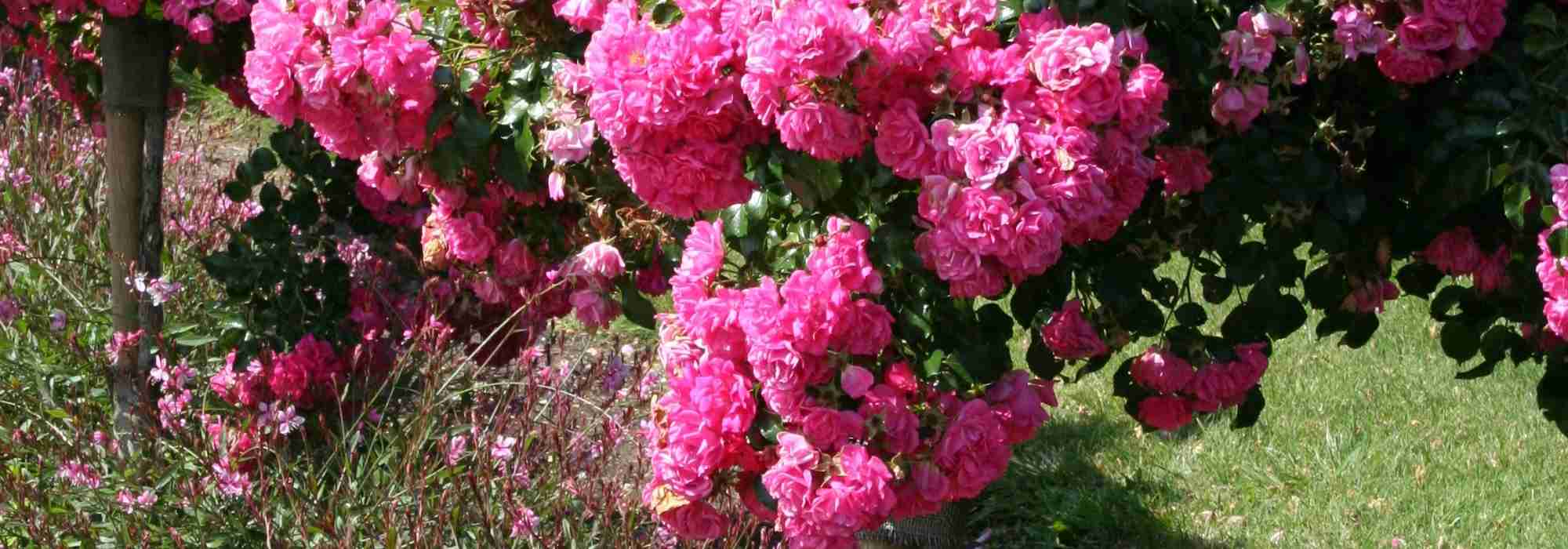
Planting a standard or weeping rose
Our tips to successfully establish them
Summary
Standard and weeping roses, like classic roses, appreciate deep, rich soil, as well as full sun. Their planting requires careful thought about placement in the garden, as they are bushes with an elegant, refined habit, and come with a few constraints because these roses grafted at the top of a tall stem, with a ball-shaped or trailing habit, are somewhat more fragile than classic roses. Discover our tips and step-by-step guide to successfully plant them… and enjoy their incredible flowering in the warmer months.
When and where to plant?
Planting period
Ideal planting period for roses, whatever their form and cultivation method, is between mid‑October and December, to optimise establishment. This period extends until end of March for roses with bare roots, and all year round for roses bought in rootball, except during frost or drought.
Where to plant?
For standard or weeping‑standard roses, you will need to decide carefully in advance where to place them: unlike bush or climbing roses, they deserve a reflexed location, these highly refined graceful forms producing either a focal point or an architectural effect in the garden. Do not overuse them, they are best showcased individually, or in binary name for example to flank a house entrance or a staircase which they will accentuate with great elegance, as well as in rose borders, or even a vegetable garden.
Regarding exposure, after all they are roses! … they therefore require a sunny aspect to flower abundantly (south, south‑east or south‑west), and shelter from wind, the latter constraint being crucial for these standard forms, which catch the wind more easily: choose a spot sheltered from prevailing winds, as the small trunks formed by your standard and weeping‑standard roses are particularly sensitive in early years.
Standard or weeping‑standard roses are planted in open ground, but pot planting is possible as it suits these compact forms very well: your standard or weeping‑standard rose can then be grown in a trough, a large jar, or even a pretty orange‑tree pot to display it. This is even very practical if soil is too sandy or calcareous to plant them outdoors!
As for soil, their need is the same as other roses, namely deep, fertile soil, which you will amend regularly. Clay soils are not a problem, on the contrary, provided they are sufficiently well drained, roses not tolerating excess moisture.
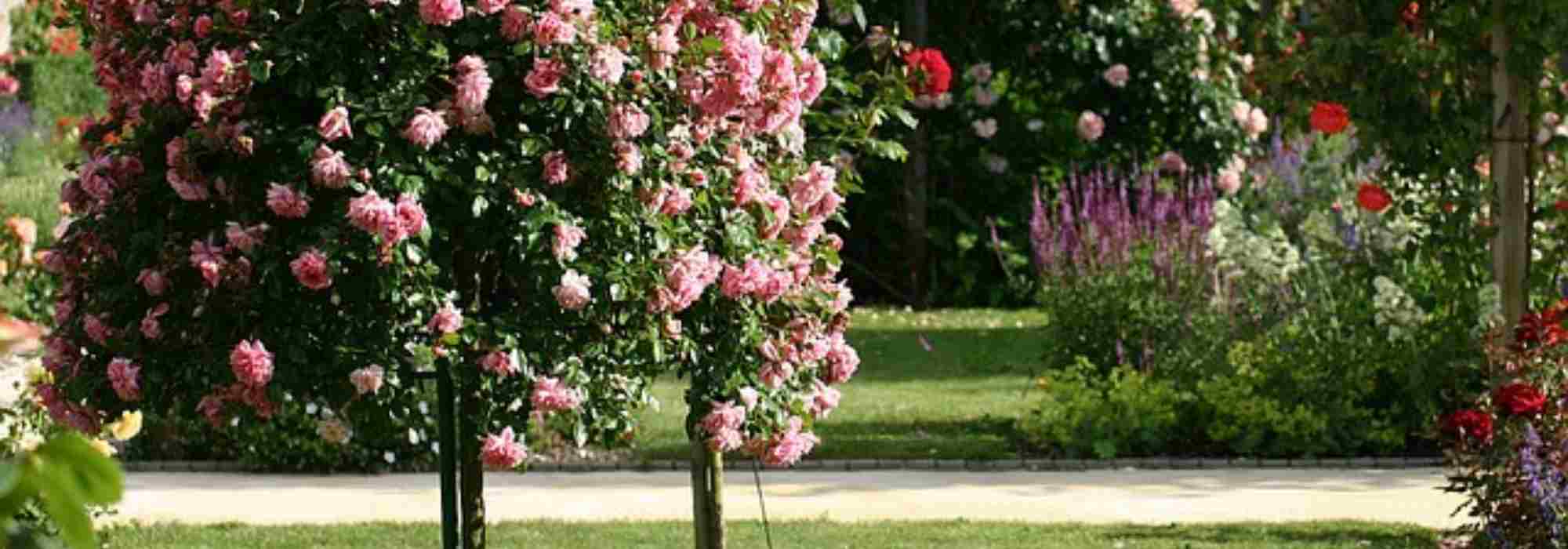
Standard and weeping‑standard roses need a very sunny location sheltered from winds
You may also read
Rose fertiliserBare-root, container-grown or root-balled roses
As with ‘classic’ roses, you can choose between bare-root young plants and container-grown young plants.
Bare-root roses establish very well and are noticeably cheaper than container-grown roses. These roses are cultivated in open ground and dug up in early autumn by nursery growers. There has therefore been no transplanting, so no stress — they are just waiting to be planted in November, ideal month for planting! Simply trim damaged roots and coat them beforehand in a slurry of water and soil (garden soil, clay) and, if desired, potting compost or cow manure to ensure best possible establishment of root system (if possible, leave for a few hours in this liquid mud). If you cannot plant these bare-root roses immediately after purchase, keep them cool, or heel them in (under a small mound of soil) if planting must wait at least a week.
Balled-and-burlapped or container-grown roses have advantage of being plantable all year round, should you suddenly feel like planting one in May! If you cannot plant within three weeks, a short heeling-in is also useful in that case. Make sure roots have not formed a root ball for roses sold in containers.

Standard rose in container (Photo: Pepinieriste 85 – Flickr)
Discover other Tree Roses - Stem Roses
View All →Available in 2 sizes
Available in 3 sizes
Available in 2 sizes
Available in 4 sizes
Available in 2 sizes
Available in 2 sizes
Available in 2 sizes
How to proceed?
Your standard or weeping rose requires careful preparation:
You should previously have prepared your bare roots roses by pruning any damaged roots and coating them with pralin.
- For both types of rose, standard or weeping, bare roots or container-grown, prune to three buds above the graft.
- Dig the planting hole: soil should be very well prepared, loosened to a depth of 50 cm and a diameter of 40 cm using a spade. Ideally prepare this hole about one week in advance.
- Prepare the soil: incorporate some well-rotted manure or compost to provide loose, well-draining soil for your rose.
- Spread a slow-release base fertiliser in the bottom of the hole, such as horn meal powder, or a rose-specific fertiliser: this will stimulate growth and the still-young root system of your roses. Add enough of your soil mixture so the organic amendment does not come into direct contact with the roots.
- Stake: this accessory is essential for your standard or weeping rose! For a weeping rose, use a stake with a top shaped like a mini umbrella. Place it at planting time and leave it in place to support the main stem of your rose. Insert it slightly into the bottom of the planting hole, positioned very straight about 10 cm from the main stem. It should reach the graft union. Secure with a soft ratchet tie.
⇒ Discover our tips on staking your standard and weeping roses - Spread the roots correctly across the bottom of the hole.
- Fill the hole with your soil mixture and firm lightly at the base; form a saucer for watering and mulching.
- Water: do not neglect this step, even if it is raining when you plant, because a thorough watering (a 10–15 L watering can) helps the soil adhere to the roots and ensures establishment.
- If planting between November and March, protect from cold by protecting the graft union correctly.
- Mulch: another important operation to protect your rose from cold. Mulch applied at planting should be spread to a thickness of 3 cm. Use recent grass clippings, well-dried leaves, cocoa or buckwheat husks, or miscanthus mulch chips, which break down well; avoid pine bark, which is too acidifying for roses.
For planting a standard or weeping rose in a pot: Choose a pot or planter about 50 cm in diameter. Ensure pot has drainage holes if not already present. Spread a 5 cm layer of gravel or clay pebbles to provide drainage. Proceed in the same way as for planting in the ground. The difference concerns the amendment: incorporate a slow-release granular fertiliser into the potting mix.
You may also read
How to stake standard and weeping roses?Care
Standard and weeping roses are compact bushes with requirements similar to dwarf roses.
- Watering : roses, as we sometimes forget, do not require a lot of water; they are very drought-tolerant and have a deep root system that gives them considerable autonomy. However, a newly planted rose needs a water supply (10 L watering can) once a week during the first year to ensure good establishment.
Whether planted in ground or in a pot, requirements will of course differ: in prolonged drought, water roses planted in ground regularly, up to three times a week. For containers, check that the substrate does not dry out to less than 3–4 cm of soil. - Mulching : renew mulch in spring to help your roses cope with forthcoming heat by keeping soil cool at their base.
- Pruning
Standard and weeping roses are not roses you would use for making bouquets; they are mainly ornamental. It is important to prune them regularly to maintain their typical globe or weeping habit and to encourage flowering. Also, to encourage continuous flowering, remove spent flowers throughout summer. Cut above a leaf cluster with five leaflets. Carry out your main pruning at the end of winter rather than in November. Remove branches growing towards the centre, and make a short prune of about 20 cm from the crown base in the first year.
Keep 4 to 6 well-formed branches to balance the globe or weeping shape.
⇒ Follow our advice on our dedicated sheet: When and how to prune a standard or weeping rose?
- Feeding
Roses are plants that are very demanding in nutrients; this is especially true for standard and weeping roses which need at least a minimum of fertiliser to support their long and very generous flowering. Well-fed, they will also be more disease-resistant.
Prefer fertilisers rich in potassium (the “K” of NPK on packaging), which promote flowering. A slow-release granular fertiliser is perfect for planting in spring. In early summer (early July), when flowering is underway and requires a little extra boost for your perpetual roses, make a second application with an organic fertiliser (type dehydrated cow manure). Apply these fertilisers at the base, lightly forking in with a hand fork.
For in-ground plantings, standard and weeping roses will be fed approximately 2–3 times from April to October. Natural fertilisers are to be favoured, such as fertilisers made from cow manure. At planting, ideally spread well-rotted compost if available, or manure. For standard or weeping roses planted in tubs, plan for a greater quantity of fertiliser, as pot substrate becomes depleted of nutrients relatively quickly. Renew substrate completely every 3 years or so.
>> Discover our range of special rose fertilisers. - Simple natural care
For your standard and weeping roses, do not hesitate to use fairly simple natural treatments, always preventively!
A natural fertiliser such as nettle manure is recommended as a preventive measure to limit aphid attacks and combat black spot (Marsonia): let nettle leaves macerate for 3 weeks, then spray onto leaves or water at the base. Do not overuse this treatment; it strengthens roses but this nitrogen input in excess may conversely attract aphids.
You can also, when conditions combine humidity and warmth, dilute bicarbonate of soda in water and spray your roses: it is an excellent preventive treatment against black spot.
Finally, another tip: a small handful of ash spread over the mulch in early spring will provide potash that will stimulate your roses’ flowering, but again, do not apply excessively.
- Subscribe!
- Contents
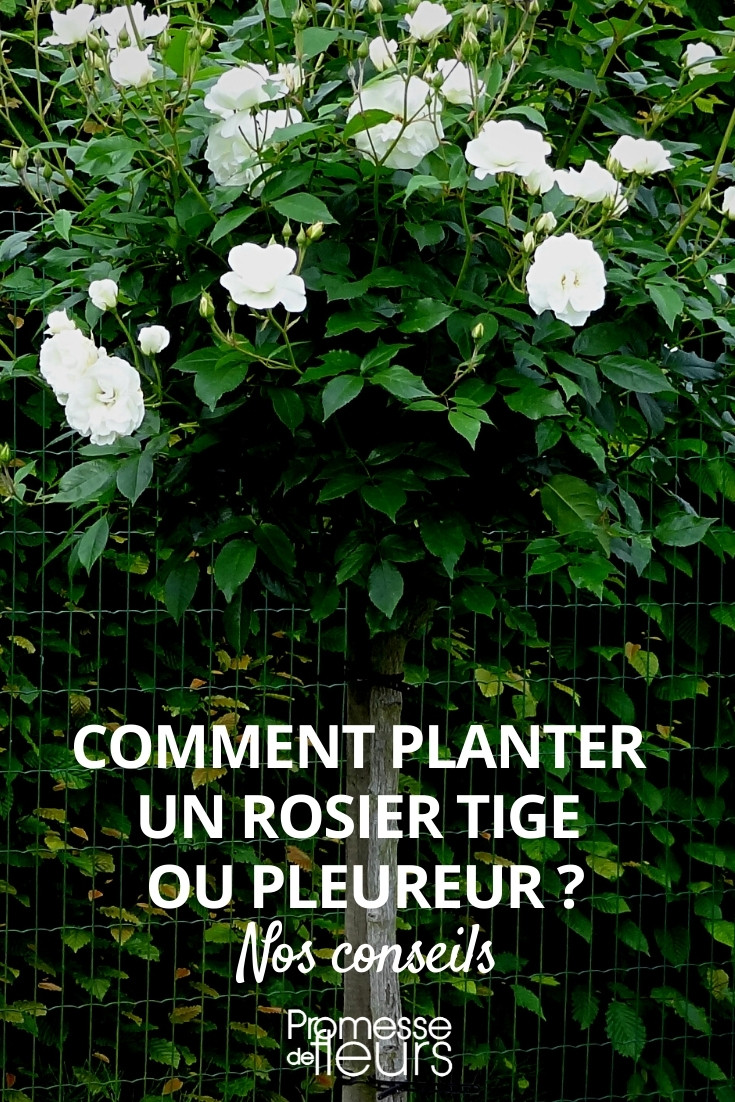































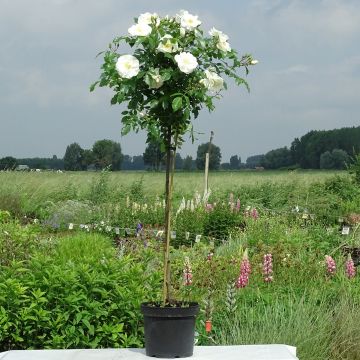
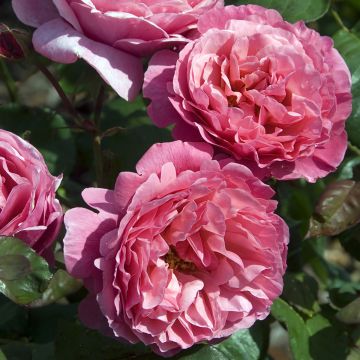
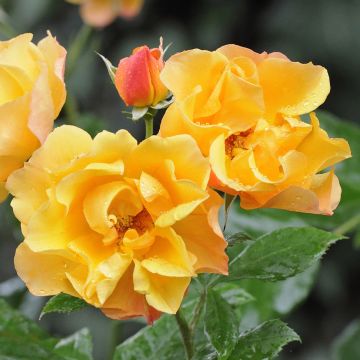
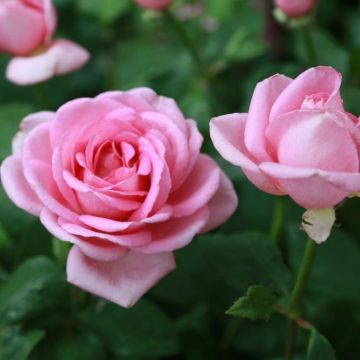
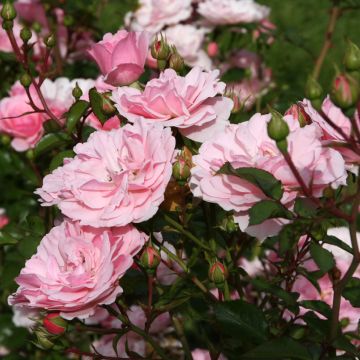
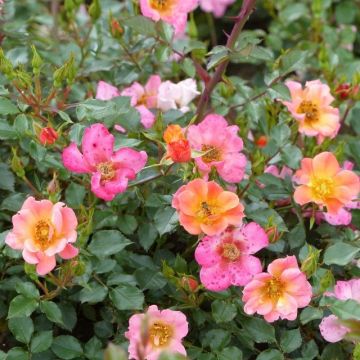
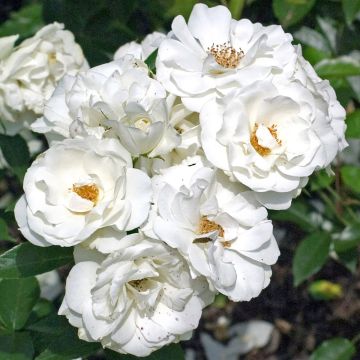
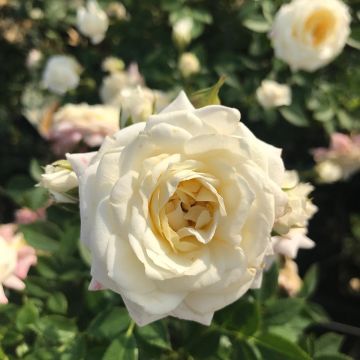
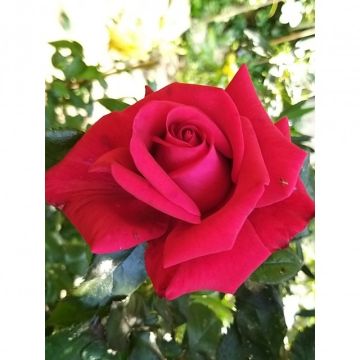
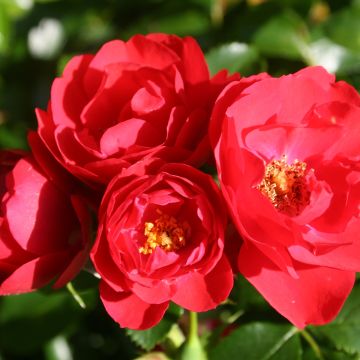
Feedbacks